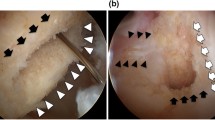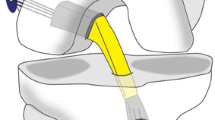Abstract
Purpose
The purpose of this prospective study was to evaluate how early the bone plug was integrated into the rectangular femoral tunnel after anatomical ACL reconstruction using a bone-patellar tendon-bone (BTB) graft via a rectangular tunnel (RT BTB ACL-R).
Methods
Twenty consecutive patients who had undergone the reconstruction procedure were evaluated by CT scans at 4 and 8 weeks postoperatively. In each scan, 30 slices for multiplanar reconstruction were collected parallel to the long axis of the parallelepiped femoral tunnel and perpendicular to the tendinous plane of the bone plug. Each slice was classified as “complete,” indicating no visible gap between the plug and the tunnel wall or trabecular continuity or “incomplete,” showing a visible gap. Bone plug-tunnel integration was evaluated as “excellent,” “good,” “fair,” or “poor” for >20, 11–20, 5–10, and <4 “complete” slices, respectively.
Results
In this evaluation, 55% of the patients were rated as “excellent” on the first scan, and 80% were “excellent” on the second scan, showing healing over time. The CT values at the anterior interface between the bone plug and the tunnel wall were also measured on both scans. The mean changes in CT value at 8 weeks were significantly lower than those at 4 weeks.
Conclusion
This study shows that bone plug-femoral tunnel integration was almost complete by 8 weeks after surgery using RT BTB ACL-R.




Similar content being viewed by others
References
Arnold MP, Kooloos J, van Kampen A (2001) Single-incision technique misses the anatomical femoral anterior cruciate ligament insertion: a cadaver study. Knee Surg Sports Traumatol Arthrosc 9:194–199
Boer FC, Bramer JAM, Haarman HJTM (1998) Quantification of fracture healing with three-dimensional computed tomography. Arch Orthop Trauma Surg 117:345–350
Brand J Jr, Weiler A, Johnson DL (2000) Graft fixation in cruciate ligament reconstruction. Am J Sports Med 28:761–774
Claes L, Augat P, Wilke HJ (1997) Influence of size and stability of the osteotomy gap on the success of fracture healing. J Orthop Res 15:577–584
Claes LE, Heigele CA (1999) Magnitudes of local stress and strain along bony surfaces predict the course and type of fracture healing. J Biomech 32:255–266
Clancy WG, Narechania RG, Lange TA (1981) Anterior and posterior cruciate ligament reconstruction in rhesus. J Bone Joint Surg Am 63:1270–1284
Drogset JO, Grøntvedt T, Myhr G (2006) Magnetic resonance imaging analysis of bioabsorbable interference screws used for fixation of bone–patellar tendon–bone autografts in endoscopic reconstruction of the anterior cruciate ligament. Am J Sports Med 34:1164–1169
Feretti M, Ekdahl M, Shen W, Fu FH (2007) Osseous landmarks of the femoral attachment of the anterior cruciate ligament: an anatomic study. Arthroscopy 23:1218–1225
Fink C, Benedetto KP, Hackl W, Hoser C, Freund MC, Rieger M (2000) Bioabsorbable polygluconate interference screw fixation in anterior cruciate ligament reconstruction: A prospective computed tomography-controlled study. Arthroscopy 16:491–498
Hoher J, Livesay GA, Woo SL (1999) Hamstring graft motion in the femoral bone tunnel when using titanium button/polyester tape fixation. Knee Surg Sports Traumatol Arthrosc 7:215–219
Hutchinson MR, Ash SA (2003) Resident’s ridge: assessing the cortical thickness of the lateral wall and roof of the intercondylar notch. Arthroscopy 19:931–935
Krestan CR, Noske H, Czerny C (2006) MDCT versus digital radiography in the evaluation of bone healing in orthopedic patients. Am J Roentgenol 186:1754–1760
Kurosaka M, Yoshiya S, Andrish JT (1987) A biomechanical comparison of different surgical techniques of graft fixation in anterior cruciate ligament reconstruction. Am J Sports Med 15:225–229
Lomasney LM, Tonino PM, Coan MR (2006) Evaluation of bone incorporation of patellar tendon autografts and allografts for ACL reconstruction using CT. Orthopedics 30:152–157
Malkolf KL, Burchfield DM, Shapiro MM, Davis BR, Finerman GAM, Slauterbeck JL (1996) Biomechanical consequences of replacement of the anterior cruciate ligament with patellar ligament allograft. Part 1: insertion of the graft and anterior-posterior testing. J Bone Joint Surg Am 78:1720–1727
Pavlik A, Hidas P, Berkes I (2006) Femoral press-fit fixation technique in anterior cruciate ligament reconstruction using bone–patellar tendon–bone graft: a prospective clinical evaluation of 285 patients. Am J Sports Med 34:220
Rahn BA, Gallinaro P, Perren SM (1971) Primary bone healing: an experimental study in the rabbit. J Bone Joint Surg Am 53:783–786
Reynolds DG, Hock C, Awad HA (2007) Micro-computed tomography prediction of biomechanical strength in murine structural bone grafts. J Biomech 40:3178–3186
Rupp S, Krauss PW, Fritsch EW (1997) Fixation strength of a biodegradable interference screw and a press-fit technique in anterior cruciate ligament reconstruction with a BPTB graft. Arthroscopy 13:61–65
Segawa H, Koga Y, Omori G, Sakamoto M, Hara T (2005) Contact pressure in anterior cruciate ligament bone tunnels: comparison of endoscopic and two-incision technique. Arthroscopy 21:439–444
Shapiro JD, Jackson DW, Aberman HM et al (1995) Comparison of pullout strength for seven- and nine-millimeter diameter interference screw size as used in anterior cruciate ligament reconstruction. Arthroscopy 11:596–599
Shino K, Kimura T, Ono K (1986) Reconstruction of the anterior cruciate ligament by allogeneic tendon graft an operation for chronic ligamentous insufficiency. J Bone Joint Surg Br 68:739–746
Shino K, Mae T, Maeda A, Miyama T, Shinjo H, Kawakami H (2002) Graft fixation under predetermined tension using a new device—double spike plate. Arthroscopy 18:908–911
Shino K, Nakata K, Nakamura N, Mae T et al (2005) Anatomical ACL reconstruction using two double-looped hamstring tendon grafts via twin femoral and triple tibial tunnels. Oper Tech Orthop 15:130–134
Shino K, Nakata K, Nakamura N et al. (2005) Anatomically oriented anterior cruciate ligament reconstruction with a bone–patellar tendon–bone graft via rectangular socket and tunnel: a snug-fit and impingement-free grafting technique. Arthroscopy 21:1402.e1–1402.e5
Shino K, Nakata K, Nakamura N, Suzuki T (2008) Rectangular tunnel double-bundle anterior cruciate ligament reconstruction with bone-patellar tendon-bone graft to mimic natural fiber arrangement. Arthroscopy 24:1178–1183
Shino K, Suzuki T, Nakagawa S (2010) The resident’s ridge as an arthroscopic landmark for anatomical femoral tunnel drilling in ACL reconstruction. Knee Surg Sports Traumatol Arthrosc 18:1164–1168
Walton M (1999) Absorbable and metal interference screws: comparison of graft security during healing. Arthroscopy 15:818–826
Woo SL, Kanamori A, Zeminski J, Yagi M, Papageorgiou C, Fu FH (2002) The effectiveness of reconstruction of the anterior cruciate ligament with hamstrings and patellar tendon. J Bone Joint Surg Am 84:907–914
Wright JM, Pellicci PM, Roberts MM, Koh JL et al (2001) Bone density adjacent to press-fit acetabular components: a prospective analysis with quantitative computed tomography. J Bone Joint Surg Am 83:529–536
Conflict of interest
The authors declare that they have no conflict of interest.
Author information
Authors and Affiliations
Corresponding author
Rights and permissions
About this article
Cite this article
Suzuki, T., Shino, K., Nakagawa, S. et al. Early integration of a bone plug in the femoral tunnel in rectangular tunnel ACL reconstruction with a bone-patellar tendon-bone graft: a prospective computed tomography analysis. Knee Surg Sports Traumatol Arthrosc 19 (Suppl 1), 29–35 (2011). https://doi.org/10.1007/s00167-011-1481-5
Received:
Accepted:
Published:
Issue Date:
DOI: https://doi.org/10.1007/s00167-011-1481-5




